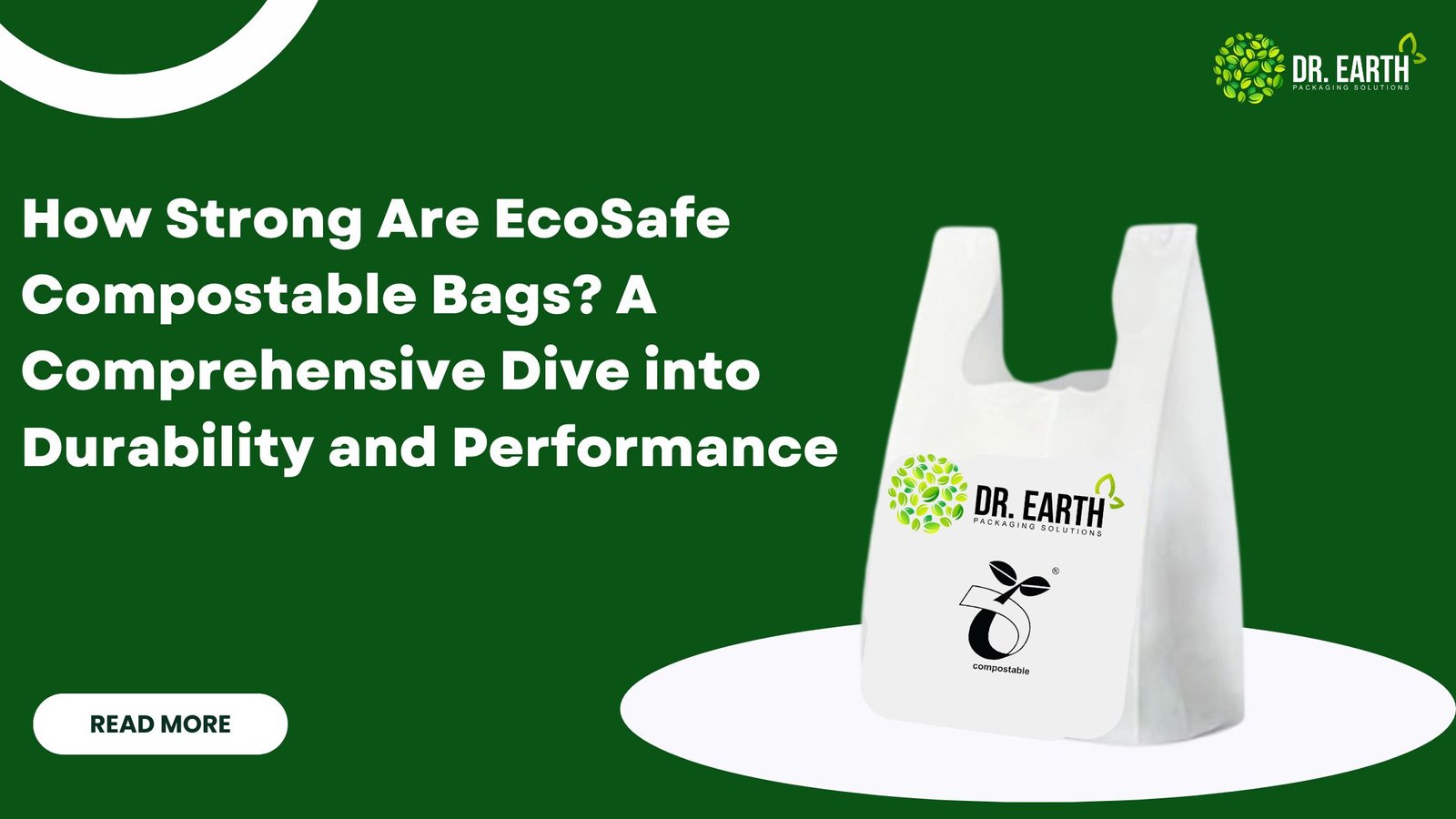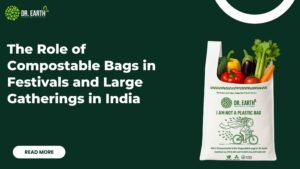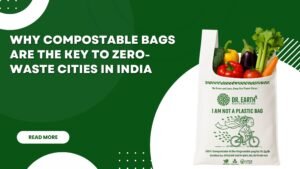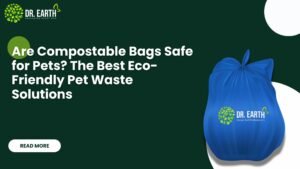
A Thorough Review of Performance and DurabilityWith the world being more eco-friendly than ever, going green on packaging has reached an all-time high. Perhaps one of the most effective substitutes for traditional plastics is compost bags. But a question lingers: how resistant and durable are these replacement bags? In this exhaustive 2000-word blog, we will discover the strength, durability, and usability of EcoSafe compostable bags, one of Dr Earth’s top-selling brands, and why they are a welcome relief for consumers and businesses alike.
1. What Are EcoSafe Compostable Bags?
EcoSafe biodegradable bags are manufactured by Dr. Earth, which is a leader in Indian green packaging. They are manufactured from renewable materials such as cornstarch, polylactic acid (PLA) and PBAT, which all have the ability to fully degrade in 3–6 months at a commercial composting facility. EcoSafe compostable bags don’t leave any toxins, microplastics, or toxic residues behind upon disposal compared to normal plastics.
Key features:
- Certified Compostable: ASTM D6400 and EN 13432 certified.
- Plant-Based Composition: 100% from renewable sources.
- Toxin-Free: Free of BPA, phthalates, and heavy metals.
2. Understanding Strength Metrics for Bags
When assessing bag longevity, there are various important metrics that come into play:
- Tensile Strength: Quantifies the ability to resist stretching. EcoSafe bags register 30–40 MPa, on par with light plastic.
- Tear Resistance: Describes how a small tear may spread. EcoSafe bags have a 0.5–1 N tear strength, adequate for normal loads.
- Load Capacity: The heaviest weight a bag can carry safely. EcoSafe bags can hold 5–10 kg per bag, depending on size and thickness.
- Puncture Resistance: Resistance to sharp items. Reinforced EcoSafe liners puncture-resistant to garden refuse and produce.
These measures show EcoSafe bags equal many plastic alternatives when produced properly.
3. Composition and Manufacturing Process
3.1 Raw Materials
Food-grade cornstarch combined with PLA from non-GMO corn serves as the starting materials for EcoSafe bags. PTAT receives mixing with biodegradable polymers to achieve both flexibility and strength properties.
3.2 Extrusion and Film Formation
Specialized equipment forms films from the heated mixture. The processing methods achieve consistent thickness measurements between 15 and 30 microns while maintaining balanced mechanical characteristics.
3.3 Bag Conversion
The movie formation process requires high-precision machinery that does the job of cutting and sealing and molding. The incorporation of reinforced seams and gussets improves both load distribution and keeps bags in good condition.
3.4 Quality Control
Each batch undergoes rigorous testing:
- Three mechanical tests are used to evaluate tensile strength together with tear resistance and puncture resistance.
- Compostability Tests: Complete breakdown within required timeframes.
- Toxicity Tests: Confirmation of no harmful residues.
Since Dr Earth maintains strict quality standards their customers receive reliable performance from every EcoSafe bag.
4. Real-World Performance: Case Studies
4.1 Grocery Retailer Adoption
A leading Mumbai supermarket chain replaced plastic bags with EcoSafe 20×30″ grocery bags. Within three months:
- Customer Feedback: 92% approval rating on bag strength.
- Operational Impact: No rise in bag-related customer complaints.
4.2 Food Delivery Services
A Delhi cloud kitchen adopted EcoSafe heat-resistant bags for takeouts. The key benefits:
- Retained bag integrity with hot, oily food deliveries.
- Attained 60% single-use plastic waste reduction in one quarter.
4.3 Municipal Waste Collection
A pilot scheme in Bengaluru used EcoSafe liners for organic waste bins. Outcomes:
- Improved decomposition of waste in industrial composting plants.
- Reduced bag-related contamination in recycling streams.
These case studies emphasize the versatility and durability of EcoSafe bags in a variety of applications.
5. Usability in Various Settings
5.1 Household Use
Household UseEcoSafe kitchen liners will take care of your kitchen waste, coffee grounds and peels, without any leaking or bursting. EcoSafe kitchen liners are sized for standard domestic kitchen bins, and retain their structural integrity until composting is achieved.
5.2 Commercial Applications
Supermarkets, restaurants, hospitals, and hotels can value EcoSafe kitchen liners for their carrying capacity, neatness, and overall versatility.
- Retail: Extremely capable of carrying heavy grocery purchases.
- Hospitality: Capable of being used during waste removal and as an in-room bag.
- Healthcare: Best for non- pathological medical waste disposal as the liner is still for single use only
5.3 Outdoor and Industrial Use
In the horticulture and agricultural sectors, heavy-weight EcoSafe kitchen liners are used to deliver mulch, discard plant refuse, and provide soil enhancers and supplements with few punctures and failures.
6. Environmental Benefits and End-of-Life
6.1 Reduced Carbon Footprint
EcoSafe bags can cut greenhouse emissions during the manufacturing process, compared to traditional petroleum-based plastics, by up to 60%.
6.2 Compostability
When EcoSafe bags are composted in an industrial composting facility, they will break down into CO2, water, and biomass, which will fertilize soil and complete the nutrient cycle.
6.3 Avoiding Landfill Methane
By mitigating the potential of organic waste to enter anaerobic landfills, compostable bags will stop methane emissions, a potent greenhouse gas.
6.4 Zero Toxic Residues
ResiduesThere are no toxic by-products left over, nor are there microplastics to contaminate and harm ecosystems and food chains.
7. Addressing Common Concerns
7.1 Shelf Life and Storage
Store EcoSafe bags in a cool, dry place. They last 12–18 months at optimal performance. Biodegradation may be advanced by high temperatures or exposure to UV radiation prior to use.
7.2 Cost Considerations
Though a bit pricier than regular plastic, EcoSafe bags bring value through compliance with the environment, brand support, and waste savings.
7.3 Composting Infrastructure
Success is tied to access to composting. Dr Earth aligns with municipalities and private composter services in order to enhance end-of-life choices.
8. Comparison: EcoSafe vs. Plastic vs. Other Bioplastics
| Feature | EcoSafe Compostable | Conventional Plastic | Standard Biodegradable |
| Decomposition Time | 3–6 months (compost) | 500+ years | 1–5 years (variable) |
| Strength | High (5–10 kg load) | Very High | Variable |
| Toxicity | Zero | Potential leachates | Varies |
| Carbon Emissions | -60% vs. plastic | High | Moderate |
| Regulatory Compliance | Fully compliant | Restricted in many regions | Varies |
EcoSafe bags consistently outperform other alternatives in durability and environmental metrics.
9. How to Choose the Right EcoSafe Bag for Your Needs
Consider these factors:
- Size & Capacity: From 10×10″ small kitchen liners up to 30×40″ large waste bags.
- Thickness: Regular (15 microns) or heavy-duty (30 microns).
- Purpose: Grocery, waste, industrial, or specialty.
- Certifications: Be on the lookout for ASTM D6400 / EN 13432 certifications.
Dr Earth’s website has a comprehensive guide and tailor-made solutions for bulk orders.
10. The Future of Compostable Bags: Innovations Ahead
Dr Earth is investing in:
- Advanced Biopolymers: Enhanced strength and quicker degradation.
- Home-Compostable Solutions: Sacks designed for home composting.
- Smart Packaging: Sensors embedded to monitor decomposition.
These technologies hold the promise of even greater durability and environmental performance.
Conclusion
Dr Earth’s EcoSafe compost bags provide excellent strength, reliable load capability, and unmatched environmental benefit. Environmental guarantee is distinctly shown through rigorous manufacturing processes, certification, and application examples, which suggest that such bags are a competent design and a vital aspect of a sustainable waste management system.
Commercial and consumer decisions to use EcoSafe compostable bags can combat plastic pollution, decrease greenhouse gas emissions, and produce a circular economy. It is time to use strength with sustainability.
FAQs
Q- 1. Can EcoSafe bags hold heavy grocery loads?
Ans- Yes, EcoSafe bags can carry up to 10 kg depending on thickness.
Q- 2. Do EcoSafe bags leak with wet waste?
Ans- No; they are designed with moisture-proof properties for garden and kitchen waste.
Q- 3. How should I dispose of EcoSafe bags?
Ans- Send them to industrial compost facilities or home compost bins if certified.
Q- 4. Are EcoSafe bags safe for food contact?
Ans- Yes; they are constructed of food-grade, non-toxic materials.
Q- 5. Where can I buy EcoSafe compostable bags?
Ans- Check out Dr Earth’s website for wholesale and retail prices.
Share:
Related Posts














